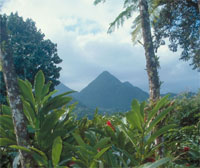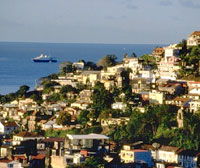Come See Beaches, Culture, and Climate in Martinique
Martinique,
a Caribbean island with a strong French history and culture,
is a haven of breath-taking beaches, a stellar climate, lush
vegetation and luxurious hotels. Yet this French-speaking island
has a unique distinction all its own, a very special je ne sais
quoi. It finds roots in the island's Creole joie de vivre --
the excellence of its cuisine, the beauty of its landscape.
It's Martinique's history, so rich in romance, drama and tragedy.
These characteristics, along with Martinique's warm and inviting
citizens with their lust for life, are what make a visit to
the island a truly spectacular and memorable experience.
Touring the island
 |
There
are plenty of tours and taxis available on Martinique, and most
drivers speak some English. Driving north from the city, one
sees old wooden structures give way to modern suburbs with sleek
apartments and office buildings. After the town of Schoelcher,
the road climbs steeply, beside the sea, then twists and turns
through picture-postcard villages like Case-Pilote and Bellefontaine.
Le Carbet is next on the itinerary. This is where Columbus landed
in 1502, "discovering" Martinique on his fourth trip
to the Americas. It is also near here, in Turin Cove, where
Gauguin lived and painted for five months in 1887. His home
was a hut built in the shadows of an old viaduct. Today there
is a museum honoring the great artist with displays of his memorabilia
and reproductions of his works.
Just outside Carbet, on a long beach below the St-Pierre highway,
there is a tiny spot called La Datcha, a simple bar-restaurant,
one of many in the area. This is the perfect spot for a quick
swim and a refreshing planteur, a potent punch drink concocted
of local rum. These are best when followed by a local specialty
-- freshly caught langouste, or lobster, boiled or broiled.
From here, travelers can move onto St-Pierre itself, nestled
under towering, cloud-shrouded Mt.-Pelée.
Once the Paris of the West
Indies
The town of St-Pierre has a somber feel. It was once a cultivated
city of 30,000 until the morning of May 8, 1902, when Mt. Pelée
suddenly erupted in an avalanche of fire, gas, and molten rock.
Three minutes later, the little "Paris of the West Indies" was a New World Pompeii, with all its inhabitants dead except one -- a prisoner named Auguste Cyparis who was jailed in an above-ground dungeon and survived to become a Barnum & Bailey Circus curiosity.
Today, about 8,000 people live in St-Pierre, now designated an official "City of Art and History" by the French Government. A small museum houses dramatic relics of the tragedy including the unrecognizable forms taken by familiar household objects, such as fantastically shaped glassware and distorted clocks melted by the heat, all stopped at the fatal hour of 8:00. Inaugurated on February 7, 2004, the Centre de Découverte des Sciences de la Terre is also located in St.-Pierre. In the garden area, a memorial to the 28,000 victims of the 1902 Mt.-Pelée volcano eruption can be visited. A serene Pelée now sits under the blue sky as though nothing had ever happened.
The return drive from St-Pierre is inland, first leading northeast to the cool breezes of Morne Rouge, then to La Trace, the spectacular route south through a tropical rain forest. The road, bordered by plunging valleys, has hairpin curves and writhes past lime, banana and breadfruit trees. There is a nice surprise at the last point before journey's end -- a miniature version of the famous Sacré-Coeur Basilica in Paris.
Sightseeing in Fort-de-France
 |
Back in the capital, visitors can stroll around the green Savane, people-watch from a terrace café, or wander the busy little balconied streets, lined with boutiques, restaurants, and pastry shops. A nice stop on a day in Fort-de-France is a visit to the Schoelcher Library. Named for Victor Schoelcher, the abolitionist, this gem of rococo-style architecture was built for the Paris Exposition of 1889 and reassembled here shortly after.
On other half-day tours, one can visit the birthplace of Napoleon's Empress Josephine near Trois-Ilets, called La Pagerie. Its museum, once the family kitchen, showcases mementos of the Creole Queen including a passionate letter from the lovelorn Emperor dated 1796.
Attractions in the south include: Le Marin, with a top-notch marina and plenty of restaurants and Ste-Anne, renowned for its gorgeous beaches, notably the Plage des Salines.
This quiet and pretty village has lots of good dining spots, a tree-shaded main square that is very typical of small-town France, boats galore, and a pier where one can board the Aquascope for tours of the island's underwater world.
Full-day Tours to the North
Since the landmass of Martinique is 425 square miles (50 miles long and 22 miles wide), there is an incredible wealth of exploring to do. On a full-day tour of the north, for example, one can visit Le Prêcheur, the northernmost village on the Caribbean with its magnificent 17th-century Habitation Céron, walks through the forest gardens, visits to cassava and sugarcane buildings, and delicious dining in a historic setting. Nearby are volcanic hot springs, and the Tomb of the Carib Indians. Inland are the Gorges de la Falaise, which are mini canyons along the Falaise River leading to a lovely waterfall.
Also on the northern Atlantic is the town of Trinité and the Caravelle Peninsula where the ruins of Château Dubuc stand. Returning home to Martinique after schooling in Nantes, Aimée Dubuc de Rivery was captured by pirates, sold into slavery, then given as a present to the Sultan of Constantinople. Like Josephine, she too became a "royal" -- Sultana Validé, mother of Sultan Mahmoud II.
In addition to the multitude of beautiful sites to visit and discover, Martinique is alive with festivals and events throughout the year.
|